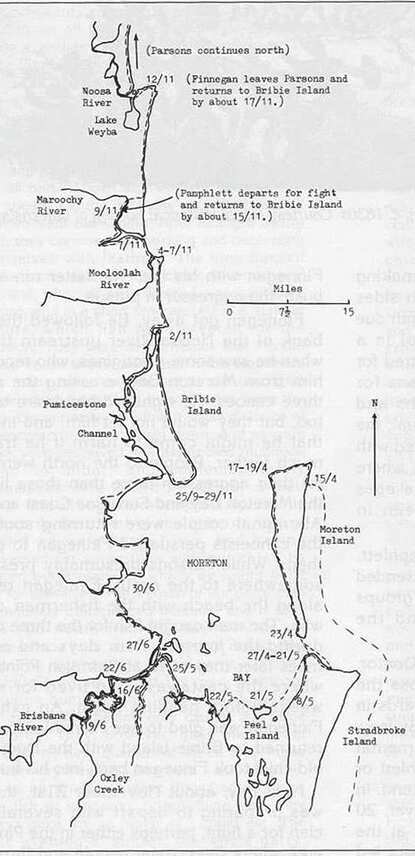Tags: History. Bribie Island. Queensland. Australian Convicts
The First White Men To Live On Bribie Island
From Glenys Mills. Bribie Island Historical Society Member
In 1823 three Sydney convicts in a small boat were caught in a huge storm which dumped them close to death on Moreton Island.
They walked around Moreton Bay, thinking Sydney was nearby and were the first white men to live on Bribie Island, being there for many months before rescue. The three castaways of Bribie Island were convict John Finnegan and two ticket of leave convicts, Thomas Pamphlett and Richard Parsons. These three convicts and another ticket of leave man, John Thompson, sailed south from Sydney on 21st March 1823 in an open boat to cut cedar from the Illawarra district.
A most severe storm blew them far out to sea on a northerly course. After 21 days at sea, Thompson died and was pushed overboard. After three and a half weeks at sea, on 15th April 1823, Pamphlett, Finnegan and Parsons landed on the northern end of Moreton Island naked, starving and almost dead from thirst.
Their boat was dashed to pieces and only Finnegan’s jacket, some flour, a keg, a tin pot, an axe and scissors were rescued. Castaways on Bribie Island Helped and fed by Aborigines, the weak castaways struggled down Moreton Island to Stradbroke Island, crossed Moreton Bay and landed near Cleveland.
Still thinking they were south of Sydney, the three castaways headed north and reached the mouth of a large river, later called the Brisbane River. They followed this river upstream to what is now Oxley Creek, crossed over and continued north up the coastline. Finally, in late September 1823, they crossed Pumicestone Passage and arrived at Bribie Island. Here the three castaways lived with the Joondoobarrie Aboriginal people.
They continued to travel north, searching for Sydney on trips with the tribe and Aboriginal fights between clans were witnessed by Finnegan in the north and south. Parsons travelled to a Bunya Feast held every three years in the Blackall Range. Pamphlett and Finnegan were lucky to be rescued after a few months and Parsons more than a year later. Rescue of Pamphlett and Finnegan In 1823 Governor Brisbane sent John Oxley in the “Mermaid “to find a new outpost for convict re-offenders.
On 29th November 1823, on looking through his telescope at Pumicestone Passage towards Bribie Island, he saw what appeared to be a white man among the Aborigines, calling out in halting English. This was Pamphlett. The next day Finnegan, who was returning from Kippa-Ring, was rescued at Toorbul Point (now Sandstone Point). Now the castaways found out how far north of Sydney they were.

The Brisbane River:
Oxley was told of a large river and he was accompanied by Finnegan in a boat to “discover “this river. John Uniacke wrote Pamphlett’s account of The Rescue of Thomas Pamphlett (J.Ashton 1886, copyright expired) the castaways ‘story. Later, on the voyage back to Sydney, Finnegan would add to the story and much information about Aboriginal culture was included.
Indeed, the castaways would never have survived without Aboriginal help. On 3rd December 1824, Oxley named the river he had discovered the Brisbane River, after Governor Brisbane, Governor of NSW. Little mention was made of the contribution by the three castaways.
Message in a bottle:
As Parsons whereabouts were unknown, (he was still travelling north, trying to reach Sydney), a bottle was left with an explanatory note when the “Mermaid” sailed on 6th December 1823 with Pamphlett and Finnegan back to Sydney. On his return, Parsons found the message in a bottle. However, Parsons was illiterate.
Rescue of Parsons:
Parsons was rescued by John Oxley the next year in the “Amity” on 11the September
Pamphlett Returns as a Convict:
Pamphlett reoffended and was sent to serve time at Moreton Bay (Brisbane) 1826-1833.
The Castaways after Rescue.
RICHARD PARSONS:
In Australia’s first census November 1828 Richard Parsons was living at Illawarra as a bullock team, driver 40 years old. He was granted an absolute pardon.
JOHN FINNEGAN:
He became a trusted government guide exploring the Brisbane River area and was a Moreton Bay pilot.
THOMAS PAMPHLETT:
He re-offended three years after his rescue and as a twice-convicted felon was sent to Moreton Bay (Brisbane) in 1826 for 7 years. He left Moreton Bay in April 1833. He died 1st December 1838 at Penrith, probably aged 50.
Acknowledgements. a. “Through the Eyes of Thomas Pamphlett” by Chris Pearce. 1990. (Now available as an EBook). b. “The Explorers” by J.G. Steele
Other Articles
https://thebribieislander.com.au/history-bribie-island-fascinating-history-historical-society/
https://thebribieislander.com.au/history-bribie-island/
